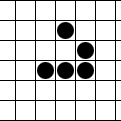Glider (Conway's Game of Life)


The glider is a pattern that travels across the board in Conway's Game of Life. It was first discovered by Richard K. Guy in 1969, while John Conway's group was attempting to track the evolution of the R-pentomino. Gliders are the smallest spaceships, and they travel diagonally at a speed of one cell every four generations, or . The glider is often produced from randomly generated starting configurations.[1]
The name comes from the fact that, after two steps, the glider pattern repeats its configuration with a glide reflection symmetry. After four steps and two glide reflections, it returns to its original orientation.[2] John Conway remarked that he wished he hadn't called it the glider. The game was developed before the widespread use of interactive computers, and after seeing it animated, he feels the glider looks more like an ant walking across the plane.[3]
Importance
[edit]Gliders are important to the Game of Life because they are easily produced, can be collided with each other to form more complicated objects, and can be used to transmit information over long distances. Instances of this second advantage are called glider syntheses. For instance, eight gliders can be positioned so that they collide to form a Gosper glider gun.[4] Glider collisions designed to result in certain patterns are also called glider syntheses. Patterns such as blocks, beehives, blinkers, traffic lights, even the uncommon Eater, can be synthesized with just two gliders. It takes three gliders to build the three other basic spaceships, and even the pentadecathlon oscillator.
Some patterns require a very large number (sometimes hundreds) of glider collisions; some oscillators, exotic spaceships, puffer trains, guns, etc. Whether the construction of an exotic pattern from gliders can possibly mean it can occur naturally, is still conjecture.
Gliders can also be collided with other patterns with interesting results. For example, if two gliders are shot at a block in just the right way, the block moves closer to the source of the gliders. If three gliders are shot in just the right way, the block moves farther away. This "sliding block memory" can be used to simulate a counter, which would be modified by firing gliders at it. It is possible to construct logic gates such as AND, OR and NOT using gliders. One may also build a pattern that acts like a finite state machine connected to two counters. This has the same computational power as a universal Turing machine, so, using the glider, the Game of Life is theoretically as powerful as any computer with unlimited memory and no time constraints: it is Turing complete.[5][6]
Hacker emblem
[edit]Eric S. Raymond has proposed the glider as an emblem to represent the hacker subculture, as the Game of Life appeals to hackers, and the concept of the glider was "born at almost the same time as the Internet and Unix".[7] The emblem is in use in various places within the subculture.[8][9]
References
[edit]- ^ Flammenkamp, Achim (December 9, 1995). "Spontaneous appeared Spaceships out of Random Dust". Bielefeld University. Archived from the original on April 13, 2009. Retrieved February 27, 2009.
- ^ Wainwright, Robert T. (1974). "Life is universal!". Proceedings of the 7th conference on Winter simulation - WSC '74. ACM Press. doi:10.1145/800290.811303.
- ^ Haran, Brady (March 3, 2014). Does John Conway hate his Game of Life?. YouTube. Archived from the original on December 22, 2021. Retrieved May 9, 2014.
- ^ Niemiec, Mark D. (2010). "Object synthesis in Conway's Game of Life and other cellular automata". In Adamatzky, Andrew (ed.). Game of Life Cellular Automata. Springer-Verlag. pp. 115–134. doi:10.1007/978-1-84996-217-9_8. Fig. 8.12 on p. 129 depicts a closely related synthesis with seven gliders and a block. The 8-glider synthesis combines two of the four-glider units described in this figure.
- ^ Chapman, Paul (November 11, 2002). "Life Universal Computer". Igblan. Archived from the original on September 6, 2009. Retrieved July 12, 2009.
- ^ Berlekamp, E. R.; Conway, John Horton; Guy, Richard K. (2004). Winning ways for your mathematical plays (2nd ed.). Natick, Mass: A K Peters. ISBN 156881142X. OCLC 560267317.
- ^ Raymond, Eric S. "Frequently Asked Questions about the Glider Emblem". catb.org. Archived from the original on September 12, 2016. Retrieved November 5, 2012.
- ^ "BlueHackers Logo". BlueHackers. Archived from the original on June 18, 2017. Retrieved July 17, 2017.
- ^ Hinton, Andrew (May 16, 2007). "The Glider as Hacker Emblem". inkblurt. Archived from the original on July 8, 2017. Retrieved July 17, 2017.
External links
[edit]- Glider Archived July 2, 2017, at the Wayback Machine at the LifeWiki
- The Glider: Proposal for a Hacker Emblem Archived July 2, 2023, at the Wayback Machine


 French
French Deutsch
Deutsch